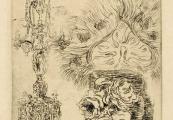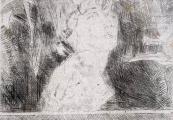This archived website ‘James Ensor. An online museum.’ is temporarily not being updated. Certain functionality (e.g. specific searches in the collection) may no longer be available. News updates about James Ensor will appear on vlaamsekunstcollectie.be. Questions about this website? Please contact us at info@vlaamsekunstcollectie.be.
Still Lives
James Ensor took a lot of motifs from his immediate living environment. From 1880, the sharp-eyed observer that he was filled his sketchbooks with studies of motifs from the interior of the parental home in Ostend. At first he was interested in the structure and the mutual relations and positions of objects. To study this he would often choose simple objects which were more or less of a similar shape.
His attention was gradually drawn to the evocation of light. A number of etchings also show Ensor's interest in still life, and, more specifically, in the effect of light on an object. Examples are Chandelier and Vase and Bust, produced in the home of the Rousseau family. The etching Skulls and Masks can also be considered as a still life. Even though Ensor used the mask or the skeleton primarily as a grotesque motif, the objects are exceptionally treated as common still life objects in this production.









